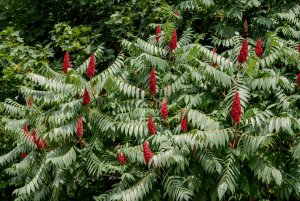Wild Wednesday: Staghorn Sumac
 You have almost certainly seen this woody shrub, the staghorn sumac, along forest tree lines or in roadside ditches, but did you know it has many foraging uses, including making a tasty lemonade-like drink? The staghorn sumac is a tough plant, able to grow in dry, degraded soil with sun or shade, whose name comes from its velvety, forking branches that resemble a deer’s antlers. This time of year, the staghorn can be found with some berries still hanging on after the winter, providing much needed food for birds and insects in early spring. As the summer comes, small flowers will start to bud and bloom, eventually turning into the erect, scarlet red berry clusters you see pictured. They are ripe and delicious by late summer and this is the time to make that lemonade!
You have almost certainly seen this woody shrub, the staghorn sumac, along forest tree lines or in roadside ditches, but did you know it has many foraging uses, including making a tasty lemonade-like drink? The staghorn sumac is a tough plant, able to grow in dry, degraded soil with sun or shade, whose name comes from its velvety, forking branches that resemble a deer’s antlers. This time of year, the staghorn can be found with some berries still hanging on after the winter, providing much needed food for birds and insects in early spring. As the summer comes, small flowers will start to bud and bloom, eventually turning into the erect, scarlet red berry clusters you see pictured. They are ripe and delicious by late summer and this is the time to make that lemonade!
Simply grab a few berry clusters off the branch from the base and crush them up in a pot or pitcher of water. Let it sit for a few hours, or even overnight for more flavor, then strain it to remove any seeds or fuzzy hairs that came off the berries (both of which are not fun to drink).
For a quicker burst of the staghorn’s yumminess, you can pop a few berries in your mouth and suck on them. Those small hairs are still not easy to swallow though, so spit it out once you’re done getting the flavor.
Before doing any of this, make sure you are not interacting with poison sumac, which is easy to distinguish as it has white berries and red stems, very different from the soft velvety branches and red berries of staghorn; contact with poison sumac would result in a reaction similar to poison ivy.
Finally, this plant turns heads in early fall, its leaves usually being one of the first to start changing color, morphing into a bright, beautiful shade of red that can make this a nice landscaping tree. So, if you should find staghorn sumac in the wild or on your property, enjoy it for whatever time of year it is and know that you can return and enjoy it more in any season.
